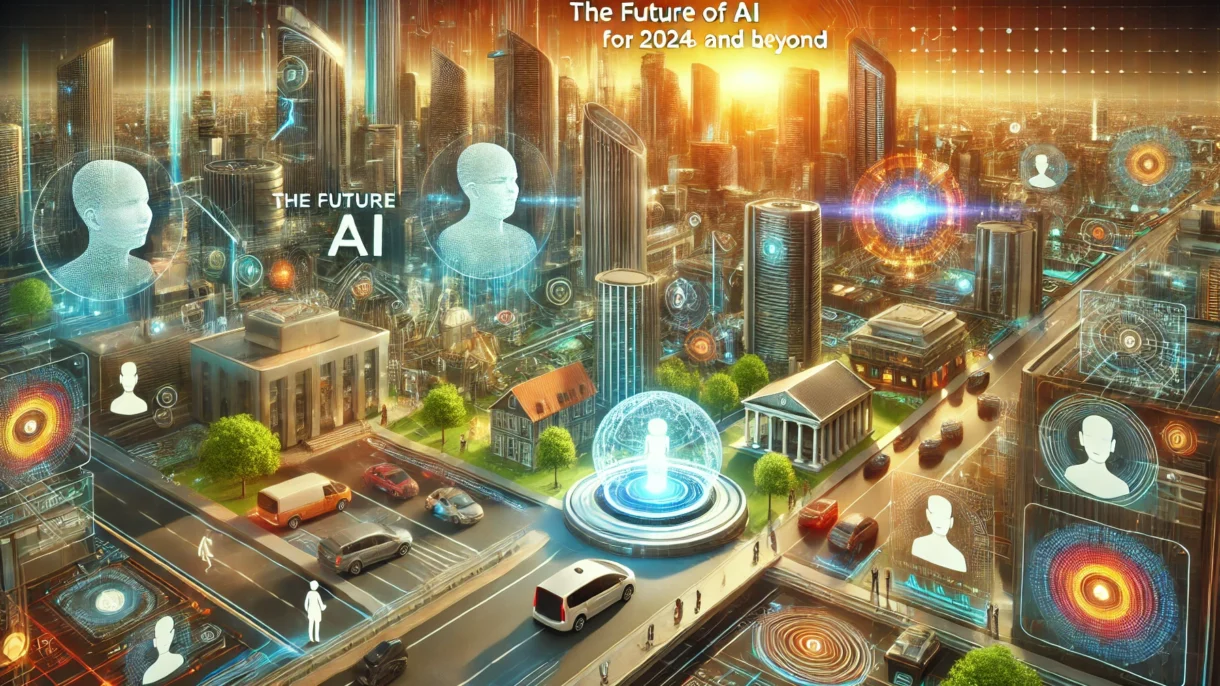Artificial intelligence (AI) isn’t just a futuristic idea anymore. It’s now a key part of today’s tech, blending into our daily lives and changing whole industries. It’s in our smartphones, boosting their power, and sparking new ideas in many fields. As we look ahead to 2024 and further into the future, AI’s potential keeps growing fast. This blog post will dive into the most exciting AI trends and what we think will happen next—showing how these changes will reshape our world soon.
From enhancing gadgets to revolutionizing businesses, AI’s impact is huge. It’s not slowing down. In fact, its influence is expanding rapidly. We’ll explore these advancements, breaking down what you can expect as we move forward.
The AI Revolution: A Brief Overview
Before we dive into what’s coming let’s quickly recap AI’s journey AI, which basically means creating machines that can mimic human intelligence, has been around since the mid-20 century. Early on, these systems were rule-based & not so powerful. But improvements in computing power, more data, and better algorithms have pushed AI to new levels. Today, AI includes a wide range of technologies like:
- Machine Learning (ML): Computers use algorithms to learn from data without being told exactly what to do.
- Deep Learning: This is a part of ML. It’s inspired by how the human brain works and can deal with really complicated patterns.
- Natural Language Processing (NLP): This lets computers read and even make up words.
- Computer Vision: This tech allows computers to make sense of visual info from the world around them.
These technologies are making big waves in various areas—healthcare, finance, transportation & entertainment, to name a few.
AI Trends Shaping the Future
Let’s dive into some of the biggest AI trends set to take over in 2024 & beyond:
1. Hyperautomation: Accelerating Business Processes
Hyperautomation merges many technologies, including AI, Robotic Process Automation (RPA), & smart software, to automate end-to-end business tasks. The goal? More efficiency, reduced costs, better decisions.
With increasing sophistication, AI will tackle complex tasks that once needed humans. Take AI-powered chatbots as an example; they can manage customer questions, leaving human agents time for trickier issues.
For a smoother hyperautomation journey, try tools like UiPath for RPA or Automation Anywhere for a full automation platform.
2. Democratization of AI: Making AI Accessible to All
In the past, AI was only used by experts and data scientists. Now, there’s a shift toward democratizing AI with user-friendly tools and platforms that anyone can use.
Low-code or no-code AI platforms are popping up. They let businesses and individuals create AI applications without needing lots of programming skills. This widens AI adoption and sparks innovation everywhere.
Platforms such as Google Teachable Machine & H2O.ai are great starting points for dipping your toes into AI without deep coding knowledge.
3. AI-Driven Personalization: Tailored Experiences
People expect personalized experiences these days—and AI delivers them. From product suggestions to content personalization, AI uses user data to provide customized options.
Streaming services like Netflix & Spotify use AI to suggest movies, shows, and music based on what you like. This level of personalization boosts satisfaction & keeps customers coming back.
For more on the world of AI-driven personalization, read “Designing for People” by David Kelley. It offers useful insights into creating user-focused experiences.
4. The Rise of AI-Powered Healthcare
AI is making big changes in healthcare, from finding new drugs to diagnosing patients.
AI systems analyze huge amounts of medical data to spot patterns & predict diseases sooner. This means earlier detection, better treatments, and improved patient outcomes. Additionally, AI-driven devices & robots make surgeries more precise and care more effective.
Want to explore the intersection of AI & healthcare? Check out TensorFlow and PyTorch—popular in medical image analysis and drug discovery.
5. Ethical AI: Building Trust
As AI spreads, ethical concerns grow too. Issues like bias, privacy, & transparency are top of mind.
There’s a push for developing fair, accountable & transparent AI systems. Organizations are creating frameworks and guidelines to ensure responsible development & deployment of these technologies.
For a deeper look into the ethics of AI, read “Weapons of Math Destruction” by Cathy O’Neil—it gives a critical view on potential biases in AI systems.
Advancements in Machine Learning (ML)
Well, machine learning is still an important part of AI. 2024? It promises big advancements in this space.
a. Increased Accessibility of ML Models
Open-source ML models & tools are on the rise, democratizing AI. More businesses & developers can access it now. Platforms like TensorFlow and PyTorch offer robust frameworks to create sophisticated models.
IBM? They say these advancements let businesses deploy AI solutions without big infrastructure investments. If you want to explore more, check out some AI tools on Amazon.
b. Low-Rank Adaptation (LoRA)
LoRA is a method for reducing the number of factors that need to be changed during training. This speeds up the process significantly—especially for fine-tuning large language models (LLMs). It makes them more efficient & accessible.
Natural Language Processing (NLP) Breakthroughs
NLP keeps evolving, allowing machines to understand & generate human language more accurately.
a. Enhanced Conversational AI
Conversational AI systems? They are becoming more sophisticated! Key things are better understanding of the situation and coming up with responses. Take Google’s Bard, for example; it’s got multimodal capabilities now. It can process & generate responses with text, images & even video inputs. Want to build your own conversational AI systems? Check out some top-rated online courses.
b. Real-Time Language Translation
Real-time language translation tools are getting better due to NLP advancements. Companies like DeepL & Google push the boundaries here, offering more accurate & context-aware translations. This is crucial for global communication and collaboration.
AI-Driven Automation in Various Industries
AI-driven automation is transforming industries by boosting efficiency and cutting operational costs.
a. Healthcare
In healthcare, AI applications are broadening from diagnostic tools to personalized treatment plans. AI systems analyze medical images, predict disease outbreaks, and even assist in surgeries. According to a study, using AI in healthcare can cut down on mistakes in diagnosis by as much as 30%. Interested in the latest AI healthcare tools? Amazon has a wide range of offerings.
b. Retail
Retail industry leverages AI to enhance customer experiences & streamline operations. Examples include AI-powered recommendation systems & automated inventory management. Retailers using AI have reported a 20% bump in customer satisfaction and a 15% cut in operational costs.
c. Finance
In the financial world, AI is used to find scams, trade using algorithms, and help customers. By analyzing vast amounts of data to detect unusual patterns, fraud detection becomes more effective with AI algorithms at work. Plus, AI-powered chatbots offer customers 24/7 assistance, improving service efficiency overall.
Future AI Trends to Watch
The future of AI will be shaped by a number of trends, including:
a. AI & the Internet of Things (IoT)
The integration of AI & IoT is creating smarter, more efficient systems. AI algorithms analyze data from IoT devices to optimize operations, predict maintenance needs (and enhance user experiences). This trend is especially clear in smart houses and IoT apps in industry. You can learn how to integrate AI with IoT in your projects with these online courses.
b. AI in Autonomous Systems
Autonomous vehicles, drones, and robots are becoming more prevalent. Advances in computer vision, sensor technology & AI algorithms are making these systems safer and more reliable. By 2024, the autonomous vehicle market is expected to grow by 20%, driven by AI innovations.
c. AI for Climate Change
AI plays a critical role in addressing climate change. It helps predict climate patterns, optimize renewable energy systems, and monitor environmental changes. IBM and NASA’s collaboration on AI-driven climate models exemplifies how AI can contribute to environmental sustainability.
AI Predictions for the Future
While predicting the exact path of AI is tough, some trends are likely to shape what’s to come.
- Advancements in Natural Language Processing: NLP is set to get even better, making interactions with AI systems more natural and human-like. Expect more sophisticated chatbots, virtual assistants & language translation services. These improvements will continue progressively. Explore advanced NLP tools here.
- AI-Driven Creativity: In the realm of creativity, AI’s role will grow. Algorithms can generate music, write poetry, and create visual art. Of course, human creativity will always be essential. However, AI will become a strong tool for both inspiration and augmentation. Discover AI creative tools.
- AI and the Internet of Things (IoT): When AI meets IoT, the result will be intelligent environments. Imagine smart homes, cities, and factories using AI to optimize energy consumption, improve safety & enhance efficiency. This convergence is set to revolutionize our surroundings. Learn about AI-driven IoT solutions.
- AI in Education: Personalized learning experiences will be achievable through AI. Students will benefit from tailored instruction via intelligent tutoring systems and adaptive learning platforms. These advancements promise to transform education fundamentally. Check out AI educational tools.
- AI and Climate Change: Addressing climate change challenges will see great help from AI. It can optimize energy usage, predict natural disasters, and develop sustainable solutions. Through such means, AI can significantly contribute to environmental protection efforts. Explore AI solutions for climate change.
In summary, these trends underscore how AI advancements are poised to reshape various fields — enhancing efficiency, creativity, and sustainability along the way.
The Bottom Line
To wrap things up, it’s clear that the future of AI is poised to change our world, bringing unmatched efficiency & creativity. Additionally, AI will drive sustainability in ways we haven’t seen before. As this technology evolves, it will redefine industries like healthcare and tackle climate change. This shift promises new solutions and a transformation of daily life. Embracing these changes is key. It helps unlock possibilities and stay ahead in a world increasingly driven by AI. Be ready for a future where AI not only boosts our abilities but also redefines what’s possible in all areas. By grasping the developments and forecasts discussed in this blog post, you can position yourself at the forefront of AI advancements and use them to foster growth and achievement in your endeavors.
Affiliate Disclosure: This post may contain affiliate links. If you click on these links and make a purchase, I may earn a small commission at no additional cost to you. This helps support my blog and enables me to provide you with high-quality content. Read my full Affiliate disclosure to learn more.



One reply on “The Future of AI: Predictions and Trends for 2024 and Beyond”
DanielLip November 8, 2024 at 4:34 am
В нашем магазине можно приобрести оригинальные товары от бренда Gucci . Большой выбор включает одежду и аксессуары , для самых изысканных покупателей.
https://boutique.gucci1.ru